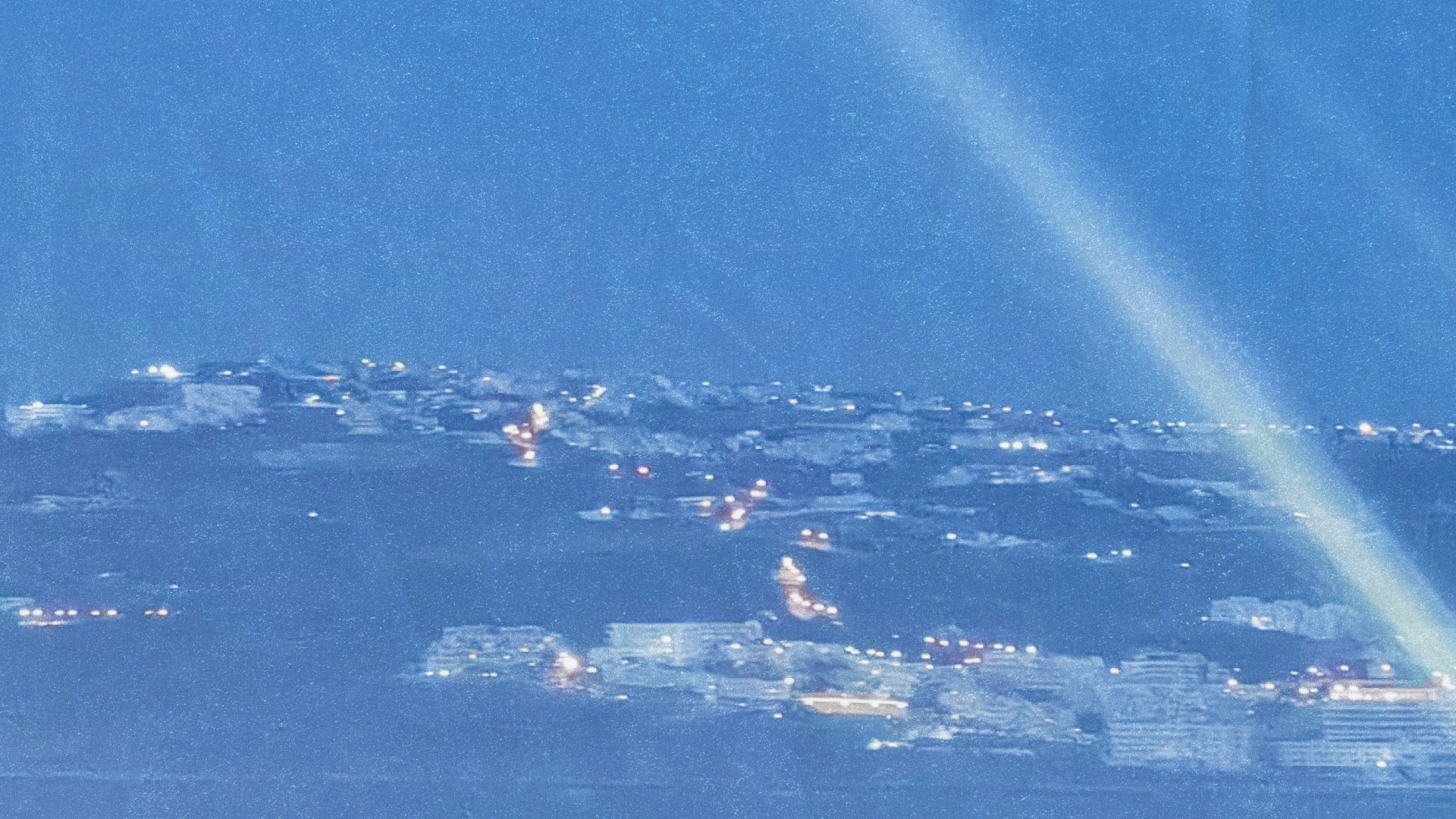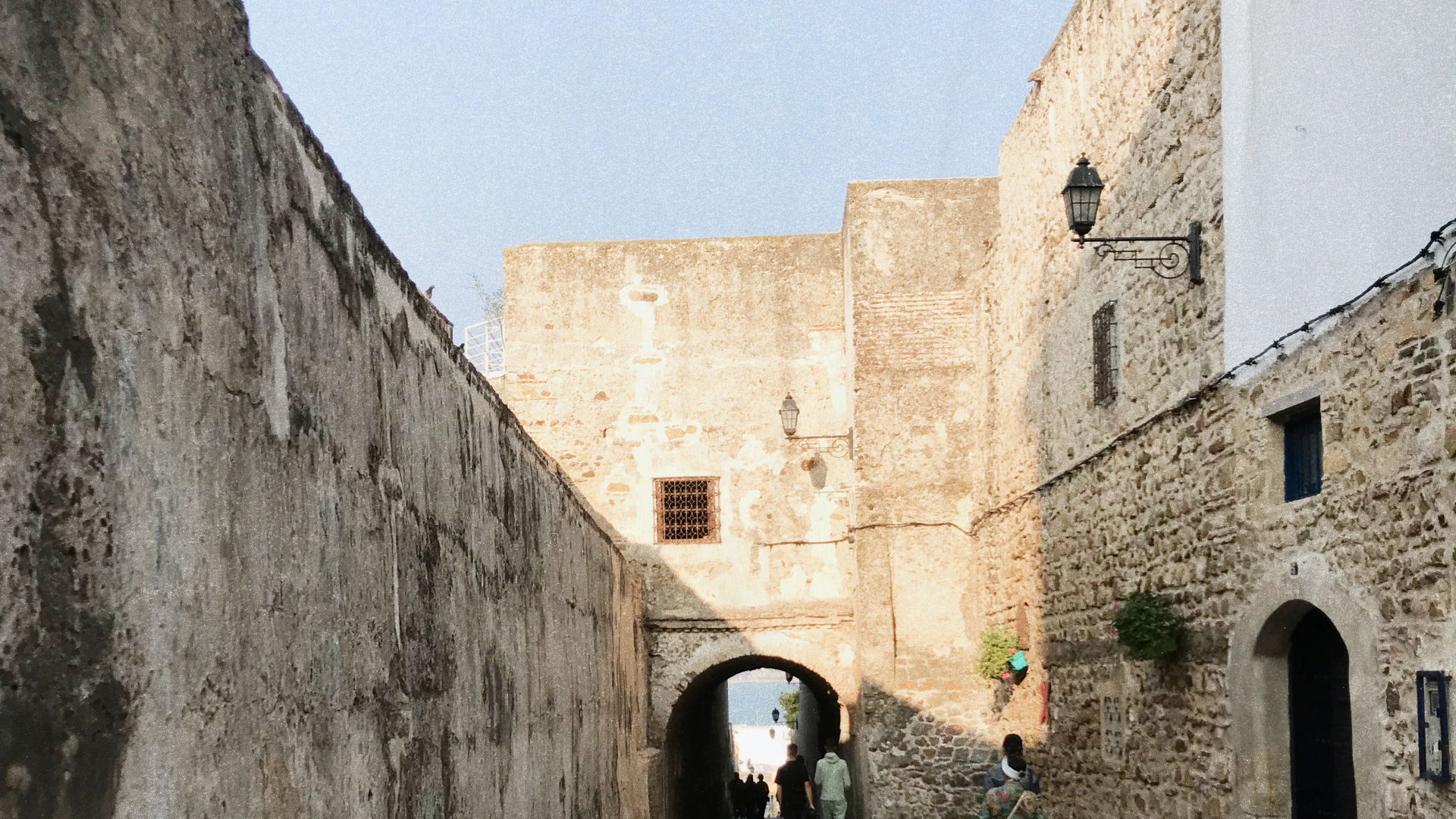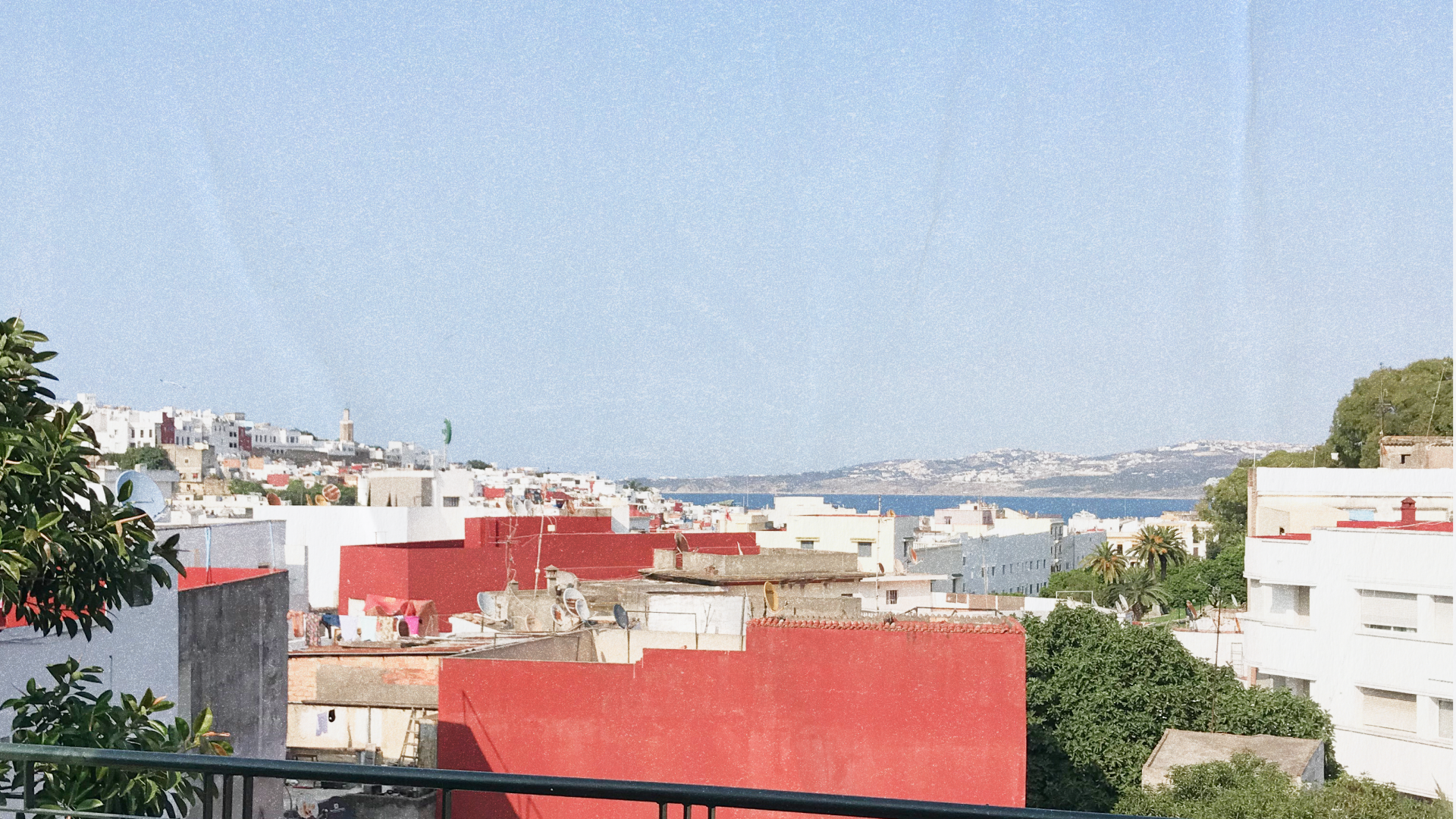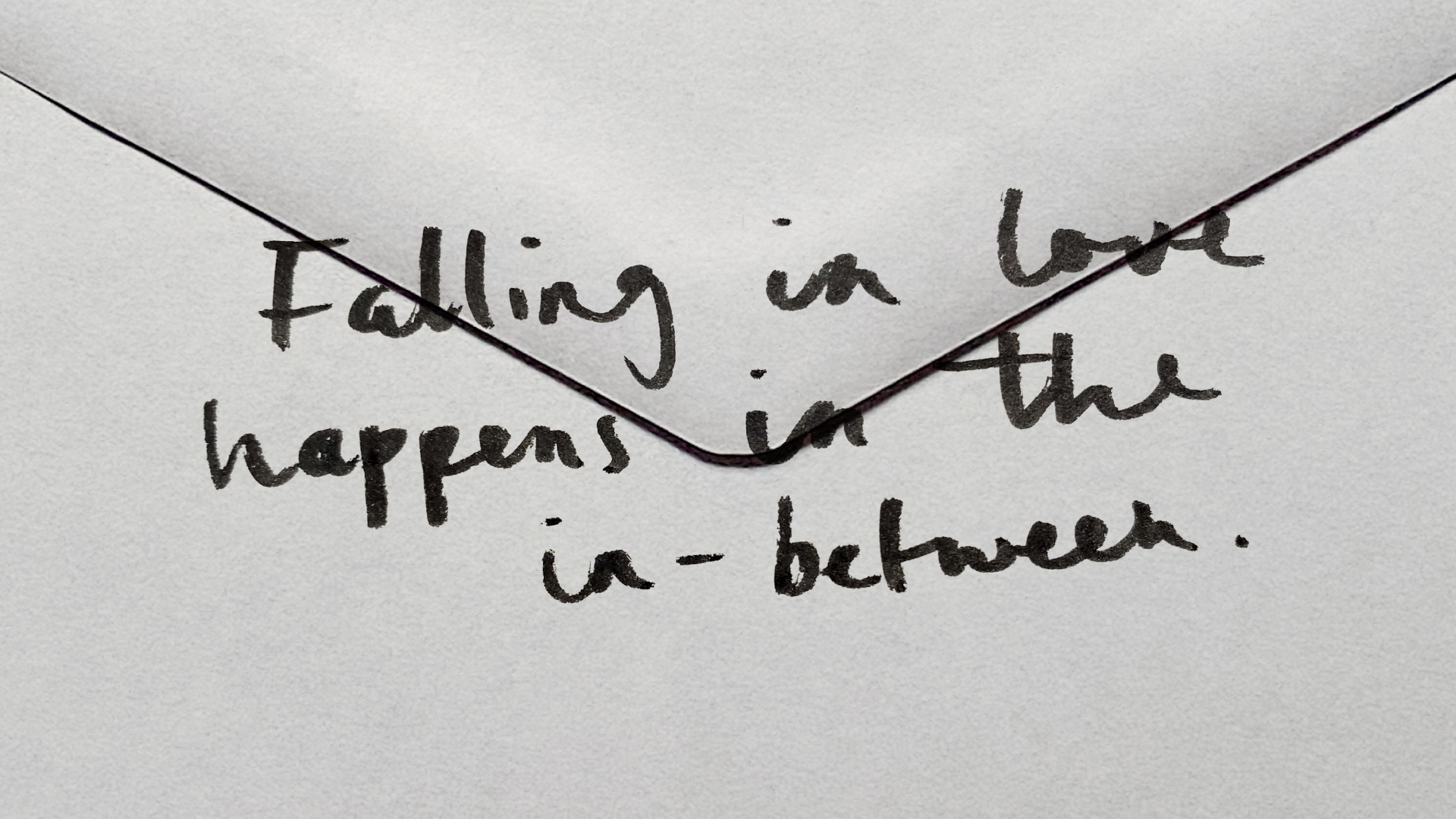Between the Two of Us

My dear,
First, I have a choice to make: am I writing this for you or for us? And is this “us” the world, or is it…us? Am I writing this just so that I can feel close to you? Am I writing because I believe, presumptuously, that you want my words—at least, on occasion? Or is it a way for me to exorcize the demons; or, perhaps, to manifest them?
Writing, I guess, is always a desperate claim of importance and self-importance, an appropriation, a distortion of reality, an insertion of meaning into the narrow slot between event and history that offers us a chance to create a story. I need this story; I need it more than you. For what a waste it would be to experience all this and not turn it into one.
This story begins in Tangier, in “your city;” actually, it began sooner, but here it begins again.
When I arrive, it is an almost full moon. The first few hours feel like a meditation (not a silent one, however). I am usually not into meditations, but this one is potent. I find a spot on one of the many rooftops of the kasbah, dining alone at a tourist restaurant, pretending to enjoy a bland blend of pasta and Tajine but really drinking in the can’t-take-my-eyes-off-you view of the medina overlooking the marina. I enjoy the vista without phone reception for 90 minutes—the duration of a football game—and watch the sun go down agonizingly slowly, as if it took time itself, and any notion of man-made chronology, with it. I listen to the evening prayers, which, as you later explain, follow a rigorous schedule, but not one that a Western metric system may ever grasp. I discern the uneven, vertiginous, and yet calmly reassuring houses of the medina, their texture within texture within texture. Pigeons and storks, mysterious silhouettes passing over vivid colors, a haze of truth, subtle energy shifts, handcrafted seismic eruptions. Men shouting in the alleys, kids playing football, store owners sitting idle.
While I’m waiting for you to arrive, I’m arriving.
The wind is getting stronger, I can feel it blowing from Spain, like a dry cold kiss that doesn’t want to linger too long on my skin. The wind is what connects us, you would tell me. The ferry to Tarifa on the Spanish side of the strait is like a mouthful of longing, one that returns every hour. For 90 minutes I barely move my head, rest in one position, and immerse myself in the privacy of my thoughts, or the complete lack thereof. “When something’s not coming, it’s coming,” Nick Cave put it when asked about the workings of inspiration.
And then you come, up the stairs.

When we stroll through the medina, eventually sitting down briefly at the café of the former Cinema Rif, the city, with its brimming understatement, eclipses us. Our attempt to make conversation is futile in the face of the many mini-spectacles unfolding on the Grand Socco in front of us, the central roundabout square where the petit dramas, the profanities, the shared taxis, and the grand farewells chisel away at any pretense of overstatement. At the dignified grittiness of this arthouse movie theater, now called the Cinémathèque but still revered for its rebellious spirit, I spot an “Entre Les Deux” poster: the perfect phrase for a gateway city situated between worlds, continents, seas, cultures, powers, and agendas; between being Moroccan and being not-Moroccan, between the secular and the fundamentalist, modernity and tradition, capitalism and religion—an “international zone” or “interzone,” to use William Burroughs’ term.
A city between practicality and devotion where time seems to both move faster and come to a halt.
A few days later, in the Museum of Contemporary Art, we watch an extreme slow-motion video showing the formation and release of a tear that eventually drops onto someone’s skin, which up close appears as thick as that of an elephant. At the Galerie Tindouf, we run into Tahar Ben Jelloun, one of the most acclaimed contemporary Moroccan writers and a budding visual artist, whose exhibition of paintings, Eclats de Lumière, is slated to open a week from now. Another Moroccan friend of mine tells me that her mother wrote her Ph.D. dissertation based on his work; it deeply inspired her to take a “radically feminist stance” at a time when those words were even more incendiary. Ben Jalloun has written all his books in French, although his first language was Darija. Besides being a writer and painter, he is also a psychotherapist by education, and it strikes me as one of the hallmark features (although the local Tangeroises would surely be too humble to use that word) of those growing up in the city that they can not only effortlessly travel between Darija, French, Spanish, Arabic, and English but also the respective cultures these languages represent, nurturing a humility that is, at its heart, pure confidence based on a keen awareness of the world.

Despite this awareness, curiosity is never jeopardized by cynicism in Tangier. The city is replete with plots and subplots, pivots of fate, and sudden outbursts of drama, but it is also full of slow, genuine reveals. Tangier needs as much time to show itself as you have time to give. Everything is a spectacle here without being staged as such, and the shapes and colors—so essential, so layered—while generous to Instagrammers, offer so much more to those who stay patient and curious a little longer.
There is no “undressing.” Everything is already here.
History, heydays, memories, and myths never get in the way of the stories unfolding, and the acute sense that so many more are still to be written.
Tangier is having a moment again, as the flagship of Morocco’s long-neglected North. The local economy has been boosted by a surge of automotive, pharmaceutical, and aircraft manufacturers growing their operations here, and the new port, Tanger Med, now counts as the biggest container port in Africa. A 2021 law allowing the cultivation of cannabis for medical and industrial purposes, while maintaining the prohibition of its recreational use, has inspired startup founders like Aziz Makhlouf, based in the northern “blue city” of Chefchaouen, to take the plunge and build a kif business in the legal market, hoping that the shift toward legalization might help farmers in the underdeveloped Rif region (the main source of the country’s cannabis production) move out of poverty. A new high-speed train, Al Boraq, connects Tangier with Casablanca and Rabat. Tourists are no longer bypassing the city, new hotels are opening, such as the Fairmont and (soon) the Waldorf Astoria, catering to the global jet-set.
And young Moroccan creatives and founders are moving here from Fez, Casablanca, and Rabat, attracted by the unique location, the more relaxed lifestyle, and not least the intertwined existing and emerging narratives the city has to offer. Two of these pioneers are the photo artist Seif Kousmate, co-founder of Koz Collective, a group of four visual storytellers, and his wife Lamiae Skalli, a former innovation manager who quit the corporate world to open the airy Alma Café in the city. They have chosen Tangier as their new home and are active members of a burgeoning design and art scene shepherded by the Think Tanger organization, itself made of Moroccan artists tired of Western stereotypes and passionate about putting forward an irreverent, idiosyncratic vision for their country and the world at large.

Their bold new vision stands in stark contrast to the patina-laden hotels of the centre de ville—El Minzah, the Hotel Rembrandt, the Villa de France—which are charmingly washed up, “claimed by the sea,” as the French for Rabbits song goes. At the Villa de France, the Portier immediately shows us room number 35 in which Henri Matisse—who lived in Tangier, “a painter’s paradise,” he called it, intermittently from 1912 to 1913— drew La Fenêtre à Tanger (“Window at Tangier”), a tribute to the city’s magical light, with the azure blue of the two seas overwhelming and sharpening his intellect at once, as it did with so many others.
In Tangier, the light is a constant, but it also constantly shapeshifts. Inviting itself into the most private corners of passion in the morning, turning everyone out onto the public streets during the day, and then wrapping both lovers and those looking for love into a velvet blanket during those slow-burning sunsets—like the one you and I were lucky enough to witness on the terrace of Yves Saint Laurent’s former residence, Villa Mabrouka, facing each other like two ferries passing in the strait.
Valerie, the manager of La Maison de Tanger where I’m staying at, a house of beautiful business owned by Canadian singer-songwriter Alex Henry Foster, tells me that he bought it after a stint in Tangier helped him recover from a grave personal crisis (similar perhaps to what Berlin did for David Bowie). It is well documented how this dusky Moroccan city has given lost souls a home, often permanently transient,
a place where “you can get lost without losing,”
as one of our own House tenets goes. Jean Genet, Tennessee Williams, and Allen Ginsberg all experienced it.
So did my parents, who came here by ferry in 1969 during their honeymoon cruise, three years before I was born in the small town of Erbach near Frankfurt, a place that I have never returned to. I remember the picture of a defunct cargo ship stranded on the rocks in their photo album, the well-groomed mustache of my dad, the baggy clothes, and how happy they both looked. I can feel my late mom here, her kindness, her goofiness, and her free, often irrational, stubborn spirit. Her adventurous heart.
Tangier lets you forget and remember who you are.
It makes sense that Matt Damon, as Jason Bourne in The Bourne Ultimatum, winds up here after losing his memory following a top-secret mission. Patricia Highsmith’s Tom Ripley (also once played by Matt Damon in a Hollywood adaptation) eventually visits Tangier, in his fifth (and last) outing, Ripley Under Water. And in Paul Bowles’ Let It Come Down from 1952, the American protagonist Nelson Dyer attempts to start a new life here. In Tangier, a new illusion follows every disillusion, every epiphany bears a new reality. The city can break your heart and also heal it. It is both addiction and cure.
Tangier is always a good escape plan. For centuries, it has not only been a hotbed for spies but also a popular destination for those eloping or wanting to bring and live their illegitimate, impossible—their true loves—here, like the Greek-American tycoon Ion Hanford Perdicaris, a notorious Tangier socialite, whose kidnapping in 1904 sparked an international crisis (but that’s a story for another day).
I realize I’m here, too, in a moment of crisis—not soul-searching, but searching for souls, grateful for small moments of attachment, like the elderly man whose path crosses mine and who tells me, proudly, about the restoration of the Gran Teatro Cervantes, to be completed in five, ten, or fifteen years. He shrugs his shoulders and wishes me a nice day, walking a few meters with me, then giving me back to the city. The city is the star, that much is clear. She says welcome, but she also says “proceed with caution,” like a lover warning you that you’re about to enter territory that might completely absorb you and that you might never want anything or anyone else.
Falling in love happens in the in-between,
the pauses between the notes, the “dead notes” or the demi mots, when your mind wanders through memories to form a story that can then fall forwards, head over heels. “When Laurène and Sacha wake up in each other’s arms, their love seems obvious, until words stealthily slip into their story,” the synopsis of the movie Silent Words reads. “I felt like you needed my words this time,” you wrote to me after Y died. “So pretentious, right? But words are all I have to offer.” I needed them so badly. Words are all we have.

I started browsing through Khalil Gibran’s The Prophet again. Prophets speak the truth, a divine truth, immutable and inconvenient. They are the “spokespeople” of God. They give meaning to what is meant to be. I wonder whether what we, the two of us—as in, all of us— need is a prophecy, perhaps a self-fulfilling prophecy, a reality that becomes real because we put it into words again and again. A self-fulfilling prophecy resides in the between-space, respecting the transcendent while also giving us agency. Between the two of us lies the divine, what is meant to be, but also “entrepreneurship” and action: what we want it to be. We can go with the flow and be the flow. It’s not a secret anymore: Between the two of us is more than just the two of us. There is no you and me if we fail to address the big challenges of “us.” And these challenges will not be resolved without us two. A third party, a larger version of us, is always looming.
Intimacy is what we desire when there’s nothing and no one left.
You and I talk about how interesting it would be to track the conversations of lovers, like a heatmap, to follow phases of closeness and distance, understanding and misunderstanding, to better comprehend the topical clusters shaping a relationship and how they reemerge or recur throughout it, and pinpoint the exact moments at which words move from being tender to hurtful, some of them violently creating irreparable cracks. How much congruence is good, how much tangential exploration is needed? How much of my own cup must I fill to fill yours? Or are we becoming more porous life containers? Must we define—and insert—the space between us? And if so, how, and how fast? What is between the two of us that must remain confidential, or even sacred, under all circumstances?
I’ve been having very vivid dreams while in Tangier (the broken air conditioner in my hotel room hasn’t helped), including one where dozens of people lying around a lake suddenly appear to be visited by demons, shaking their heads ecstatically as if they were losing their minds before being pulled by some ulterior force and dragged away with supernatural speed into the nearby forest. It was a strange scene, and only now do I remember that I saw Arthur Miller’s play The Crucible, a parable about witch hunts, performed a couple of weeks ago in London.
Tangier has none of the spiritualist vibes characteristic, for instance, of the Portuguese town of Sintra. The spiritual manifests itself more in the day-to-day rituals here, it’s how one lives, more or less devout, and the natural is on such an elevated plateau that it is transcendent by default.
“Culture, when it loses its sacred sense, loses all sense,” Leszek Kołakowski, the Polish philosopher contends. Despite all the trade, the film noir underbelly, and the apparent realpolitik, Tangier has maintained that sacred sense.
It is easy to romanticize Tangier, and I’m obviously prone to doing so. But while I can’t possibly know for sure, I do have a feeling that even if the magic fades one day, the glow will not. If you follow the invitation, and she welcomes you in, you can fall in love with Tangier quickly. The honeymoon can end fast, too, but is succeeded by something profound,
a special relationship more enchanting than friendship and more lasting than romance.
“Love one another, but make not a bond of love: Let it rather be a moving sea between the shores of your souls,” Khalil Gibran wrote on the topic of marriage. Between these two shores lies a solitude that is fortitude, a safe ground where the two of us can meet without losing our minds, without the explosive mix of oxytocin, dopamine, and norepinephrine that renders love an addiction, a space where our giggly giddiness and euphoria of infatuation is guided by infinite generosity.
One must not confuse this generosity with grandiosity. Generous are the small gestures, the smallest wing (like the one honoring writer and adopted Tangerois Paul Bowles in the American Legation Museum, the oldest US-government-owned property abroad, big enough for his typewriter, two chairs, and the vast imagination of The Sheltering Sky), the pleasures and exchanges that spring from a spirit of giving. In Tangier, complex matters become simple joys.
Generosity is the virtue you appreciate most in a man, you respond when I ask you the question from the Proust Questionnaire. “Because it is the source of all other virtues,” you say. Tangier is an invitation to be generous: with your time, your attention, and your heart. “Le premier amour est toujours le dernier,” proclaims the eponymous book by Tahar Ben Jalloun: the first love is always the last.
In the taxi on the way to the airport, a solitary voice is singing a prayer on the radio, and as I’m passing by parts of Tangier I’ve never seen before, a deep sadness engulfs me. It’s the beginning of a great story that has just ended, and the end of one that has just begun.
And in between, there is us.
Tim
